Hannah reveals the careful behind-the-scenes work that brings the wild spectacle of Red Bull Rampage to the masses.
Words by Hannah, photography by Joe Wakefield and Hannah
Contrary to every normal human instinct, you stand at the edge of the 40ft ledge and picture throwing yourself off it. Arcing through the air, arms moving through the compression on take-off, you get ready to spot the landing 40ft below. Impact, compression, stick the landing, go with the rebound, look to the next feature. All of this needs to happen in about 2.5 seconds, and you made it! Except, that was just in your head and believing you can do it is just one step along the way to actually doing it. And when you actually do it, there’s every chance you won’t ‘just’ make the drop – you’ll probably backflip it, or throw both arms out wide in a no hander. This is Red Bull Rampage – where your heart is in your mouth, but your head has to be firmly in the game.

Even if you’re not a mountain biker, there’s every chance that clips of Red Bull Rampage will make it through to your social media feed. It’s such a spectacle that it jumps the algorithm fence of other two-wheeled content and plays itself out in front of millions of viewers. This year’s biggest social media sensation was Tom Isted’s “wildest 10 seconds of my life” which saw his second effort at clearing his ‘BFC’ – the 74ft ‘Big F*cking Canyon’ gap that’s been played out to 43.1 million pairs of eyeballs at the time of writing. It’s perhaps a little ironic that this version of mountain biking is what makes it to the attention of non-riders, since Red Bull Rampage is pretty far removed from what most of us get up to on our own ‘mountain bikes’. Or at least it is when all you see is the 30-second social media clip, or even the competition day live broadcast. Behind the scenes and in the weeks leading up to that ‘high-production values’ finale is a whole world of more work. Here in the dust and grit, the ground is prepared so that riders like Tom can unleash their potential.
Latest Singletrack Merch
Buying and wearing our sustainable merch is another great way to support Singletrack


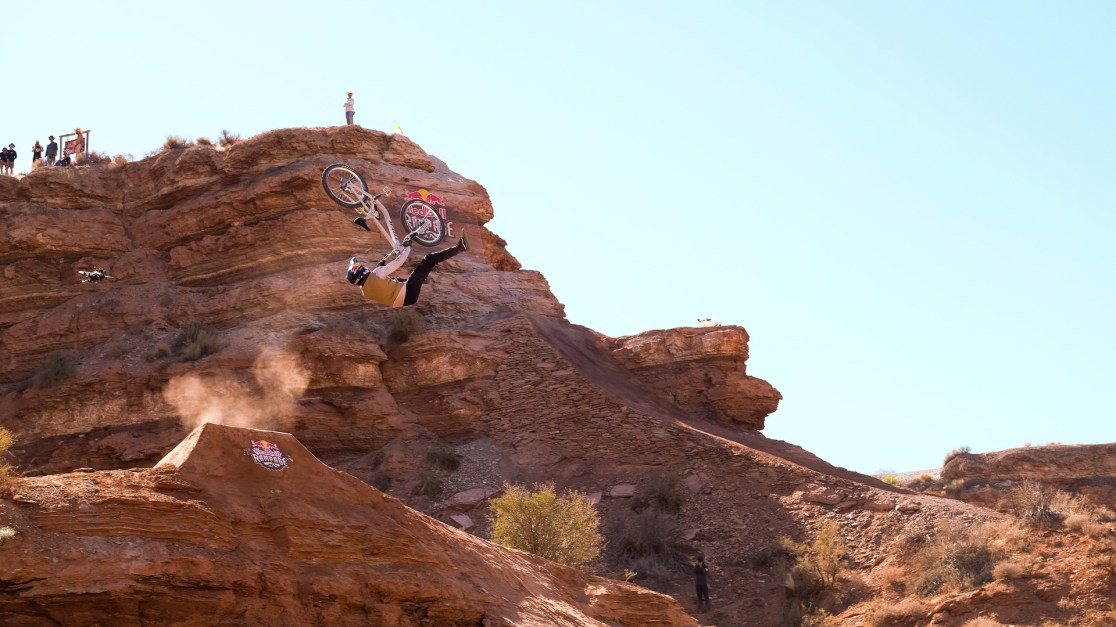
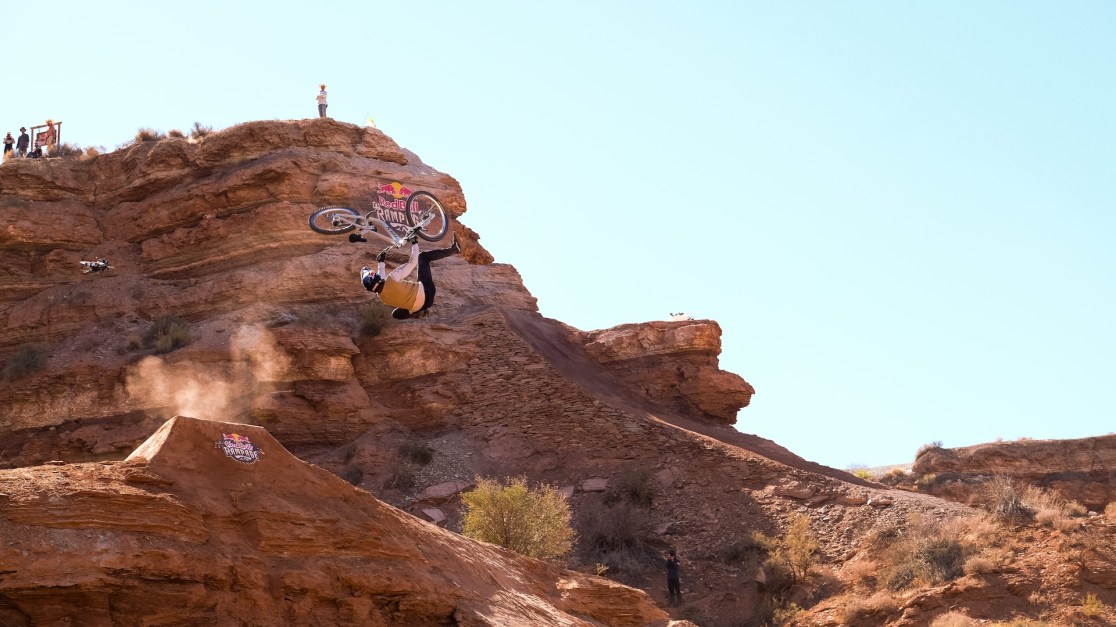

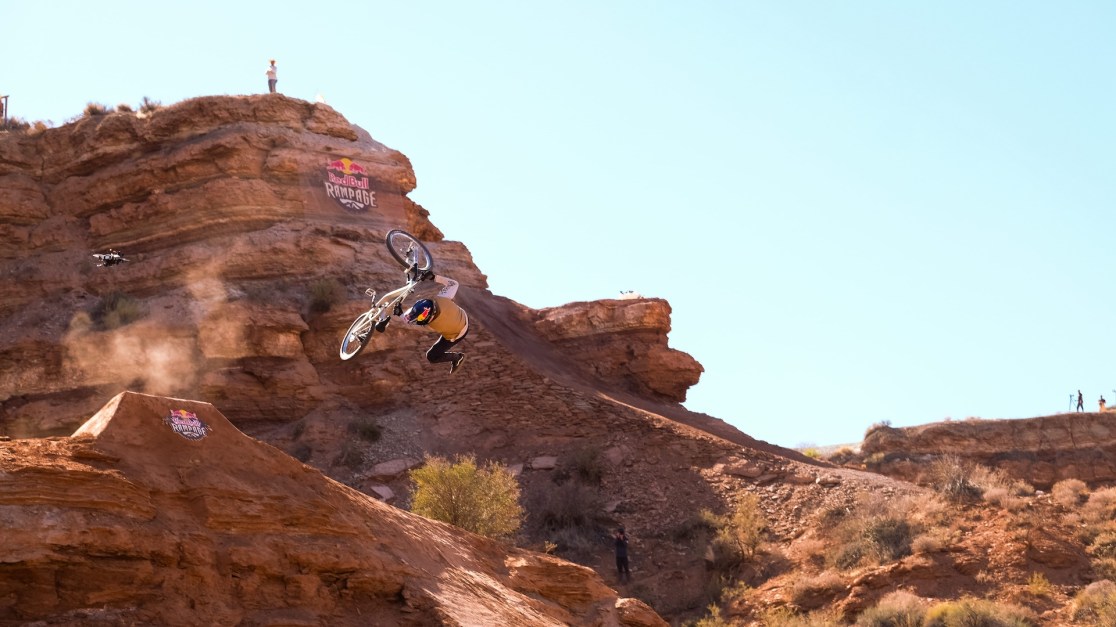
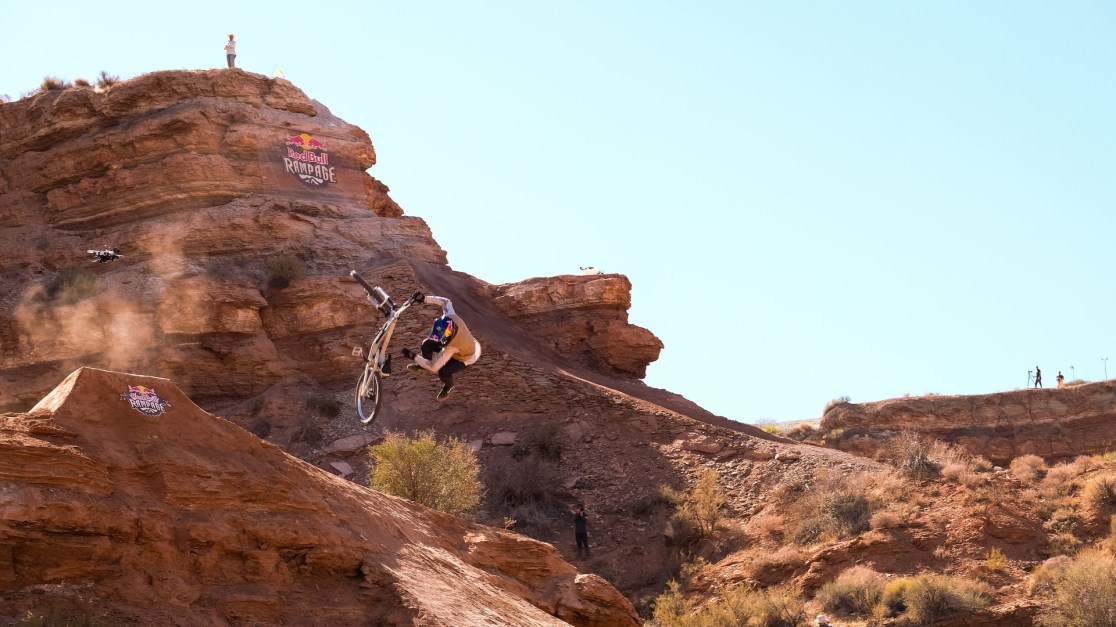
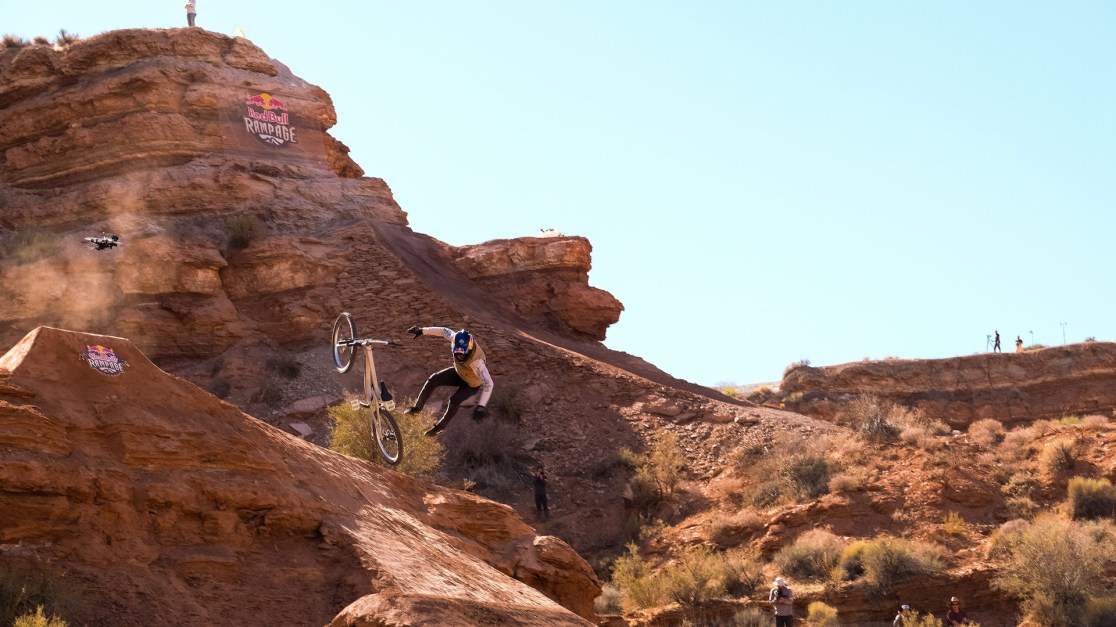
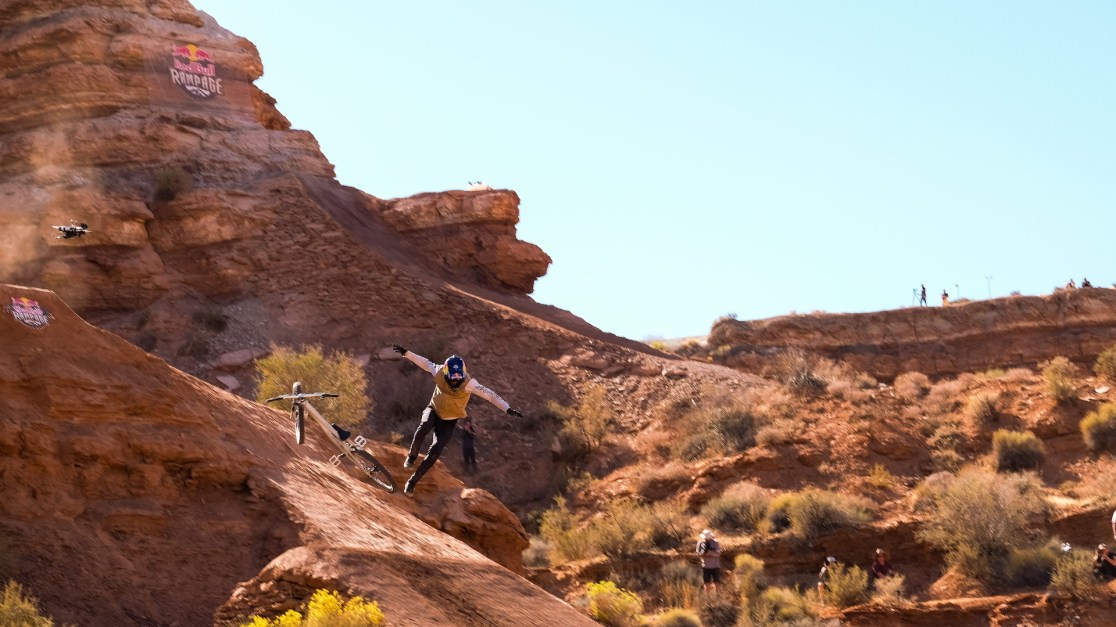


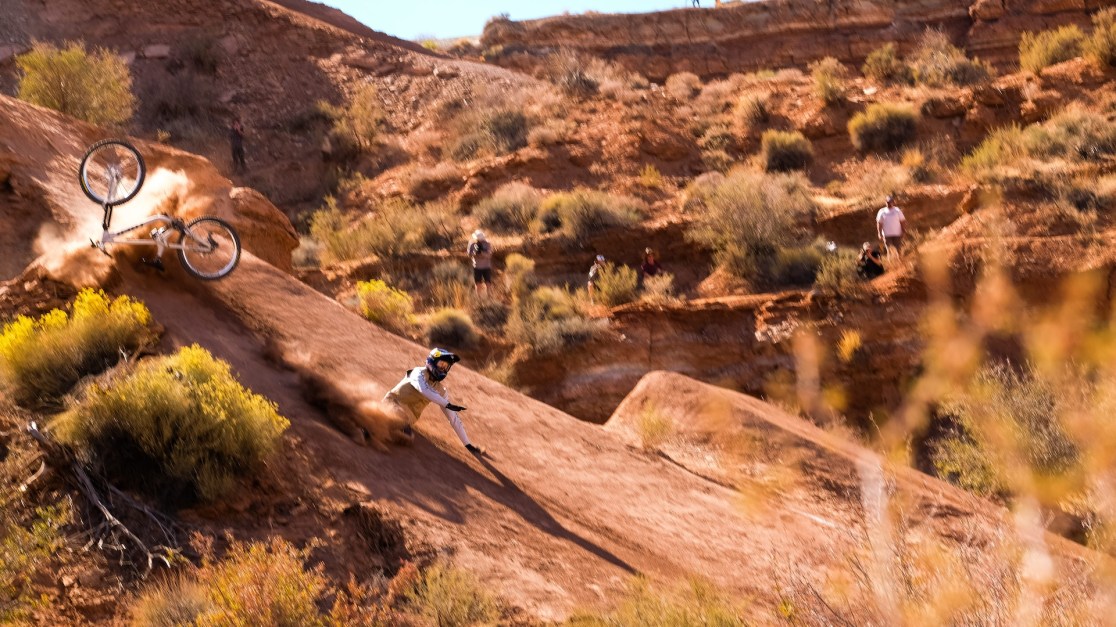
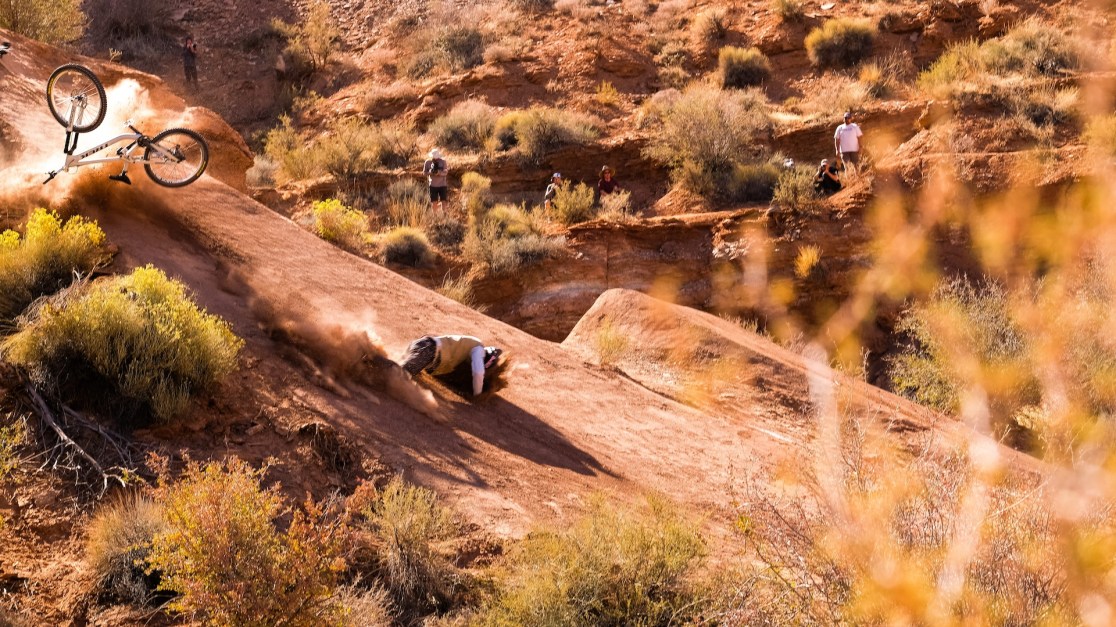
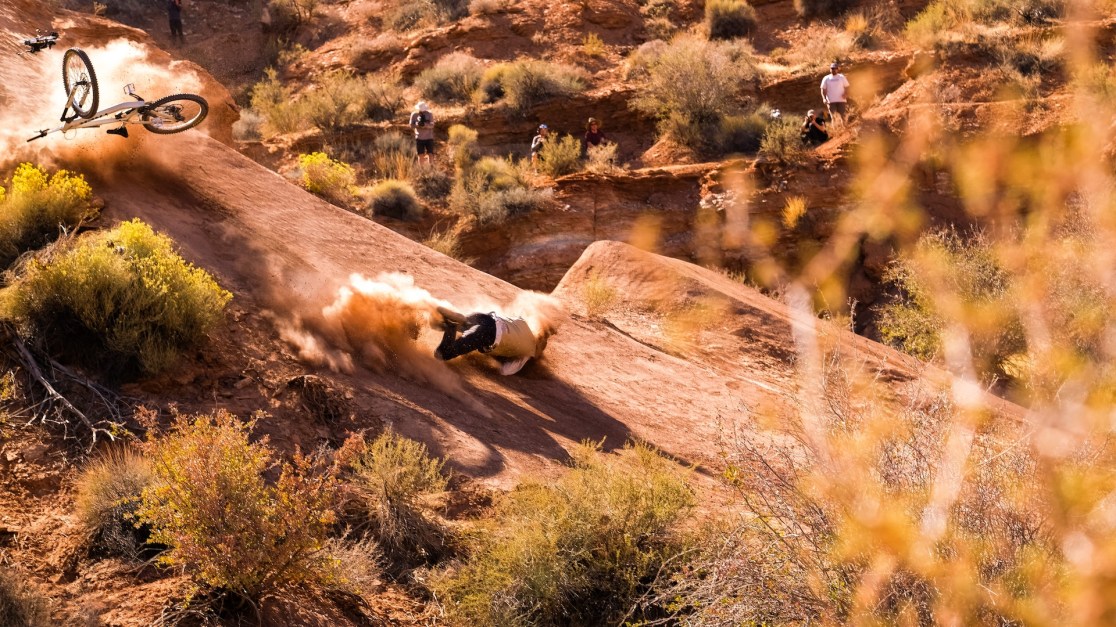

Gallons when every drop is precious
Work on the logistics for the event begins in earnest around June or July, months before the October dig days. One of the biggest projects is the water system – a complex construction of hoses that delivers water to the dig teams on the hillside. This system has brought about the biggest changes to Red Bull Rampage over the years. With water, you can build the kinds of landings and features you need to go big and do tricks. Without water, the earth remains loose dust, and lines are barely there routes scratched into the dirt. With water, the clay in the dirt turns dust to cookie dough that can be quickly packed and sculpted under just the force of a shovel. Despite the introduction of water systems that now allow dig teams unlimited water even at the highest reaches of the course, tactics remain.
Although the water system delivers water up the hillside, it’s down to the dig teams to provide the hoses to tap into the junctions provided. Chelsea Kimball, experienced in building in the Virgin desert, brought three 75ft hoses. Any shorter, and her digger CJ Selig tells me they’re less useful, but the 100ft ones are a lot more expensive. Alex Reveles, a veteran digger and good friend of Tyler McCaul, tells me that they would bring their own Y-junctions to add in, meaning they could run multiple hoses off one junction and not have to wait until the official Rampage infrastructure team provided an extra split. Tom Isted, new to Rampage in 2024, found his progress frustrated one afternoon while the water was turned off and a junction added – losing him time on finishing a feature and pushing back practice time. It’s all these little decisions, judgements and logistics that teams have to contend with as they make their way towards competition day.
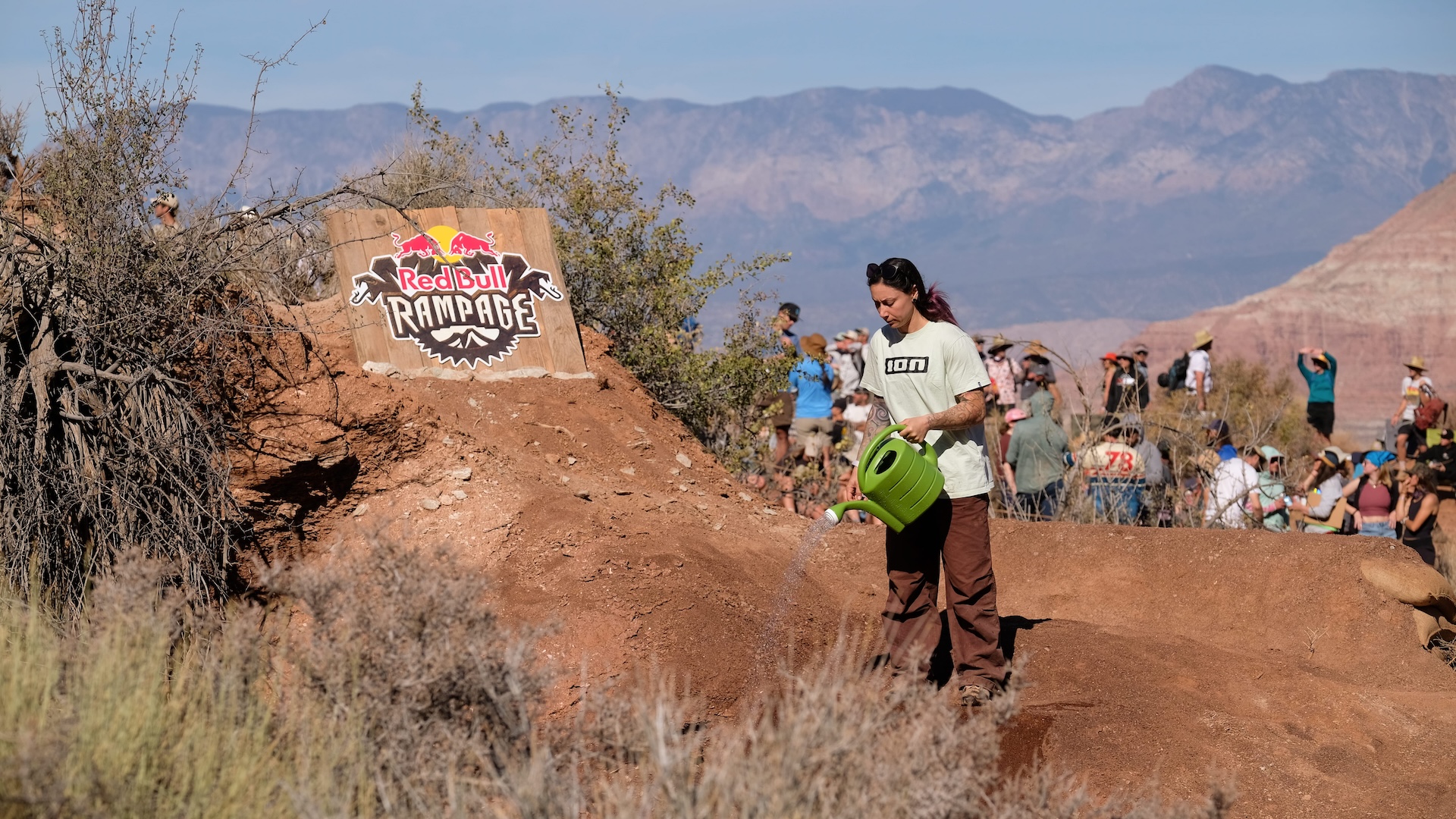
And there still are more water tactics… As the competition day approaches, the hose infrastructure is removed, pulled down the hill, until the whole course is clear. This means that the upper features in particular can dry out before it’s time for the final practice and competition runs. Teams hurry to stash buckets and watering cans of water on the hill, filling them up before the hoses are pulled in the hope that they’ll have just enough there to dampen critical parts of the features for the competition. It’s a flashback to the early days of Rampage, when teams had to haul any water they wanted up the hill in buckets and backpacks. Even with water stashed there are consequences to watering too early in the day, only to have a wind hold on course cause a delay and your feature to dry back out. Soft, dry landings can cause crashes and wipeouts, or be too fragile to offer a good chance of a clean second run. Where features are shared between riders – as is usually the case for the bigger landers – these consequences stack up for the last down the hill. The difference between hitting a feature in practice when it’s freshly watered and packed down and hitting it in competition after it’s had a night to dry out, can be huge. What the riders are looking for here is consistency, minimising the number of variables in the calculus for each feature. It’s about as far as you can get from the ‘speed is your friend, just send it’ advice you’ll hear at your local bike park.
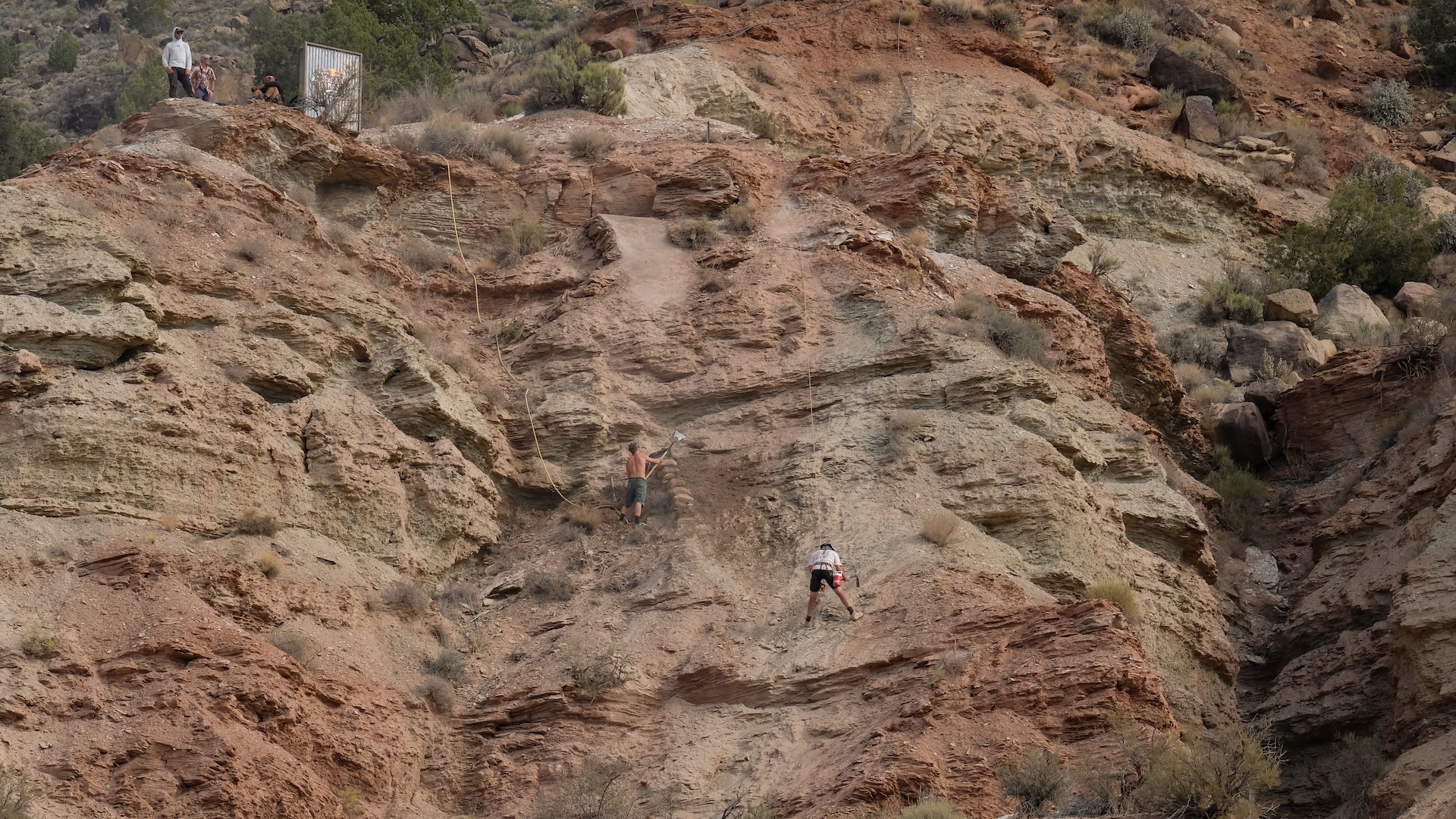
Your bag limit
The scale of the effort involved in digging the features encourages collaboration between riders, as does the 75 bag limit on the number of sandbags each team has. Sandbags are a relatively quick way to build walls into which you can pile dirt – easier certainly than the incredible stone-walling effort undertaken by Reed Boggs’ team this year. The huge lander was a solo effort for his team, and would have needed way more than his 75 sandbags to complete. As it was, it pushed the team to the limit on construction – they only finished the giant lander for his 50ft drop the night before competition, and were still digging the final pieces of his line as competitors waited for the wind to drop enough to get practice in on competition day. With the wind not playing ball, Reed used his first run to guinea pig the hit with the huge lander – hoping to be able to trick it on the second run. When the winds picked up again and kept him from his second run, Reed was left having put in all the effort on the build, but missing the chance to really dial in the timing before competition. It’s a good example of the potential consequences of biting off more than you can chew in the build phase.

Speed is everything
Guineaing a feature in competition is not what you want. It’s a process that, ideally, you want to take your time over. Riders have different tactics for figuring out their features, but all involve a process of some sort that takes them from putting down the shovel to being able to visualise what they need to do through to actually doing it. Not everyone measures their features – it’s hard to do it meaningfully since there are different axis at play. Measuring the gap between a take-off and a lander is all very well, but where is the lander in relation to the take-off? Is it above – a step-up – across, or below? There’s a spectrum of sorts between a drop, where the lander is mostly down, rather than out, from the take-off – a step down, where the lander is more out of the way – and a gap jump, where the lander is way out, but perhaps not that far down. And, in the scale of things out here, when does a gap become a canyon gap? While the physics in speed and trajectory could be the same, the head game when the gap between your features drops away 100ft is quite different.
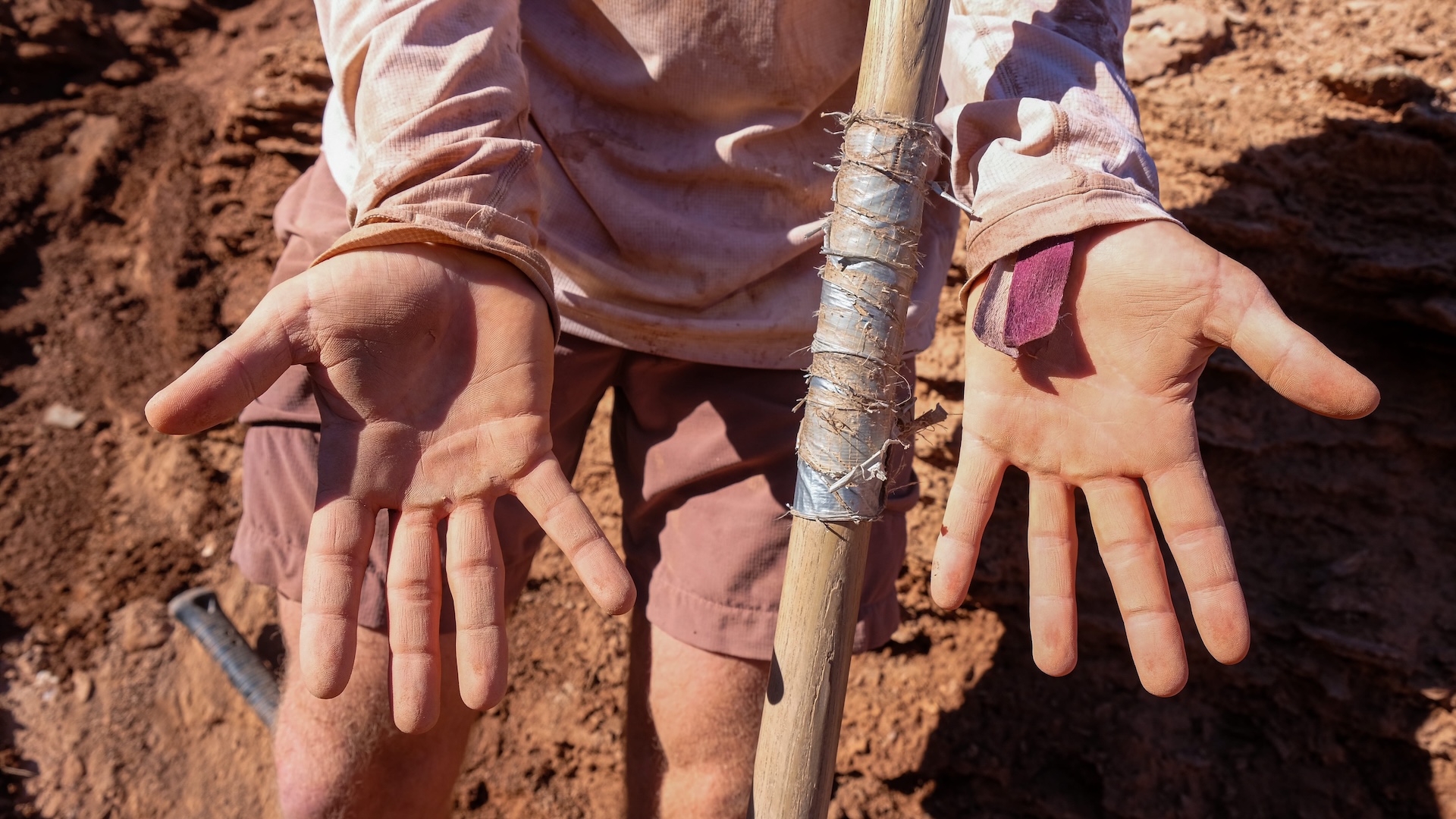
It would be wrong to say these riders feel no fear. They feel the fear, but do it anyway – or perhaps because of it. They know that on the other side of the fear, getting it right leads to a massive buzz. But the consequences of getting it wrong are significant and when they’re figuring out a feature, it’s experience and intuition rather than science that is at the fore. For a feature with airtime, you’ll see the riders standing on the edge of their take-off, trying to visualise the speed needed to take them from here to there. Sometimes they’ll throw a rock or a pebble to help them visualise the speed and momentum needed to make the distance out to a landing. Other times, they’ll run or roll up to the edge, with friends and dig teams watching. Riders make sure their dig teams know how they ride, so these onlookers can then give feed back – ‘a little faster’, ‘way slower’, ‘just like that but with pop’. Once they think they’ve got their speed nailed, and they’ve picked the exact spot they want to take off from – you’ll often see it marked with small stones – they’re ready. Wait for the wind, keep in mind what those practice roll-in speeds felt like, remember to pop (or not)… and go. Chelsea Kimball is a role player, miming out the moves and talking to herself until it’s embedded in her mind, while Georgia Astle is more of a thinker – a few rolls in and once she can envision herself carrying out the whole move, she hits it. Slightly different approaches, but still that careful calculation and execution.
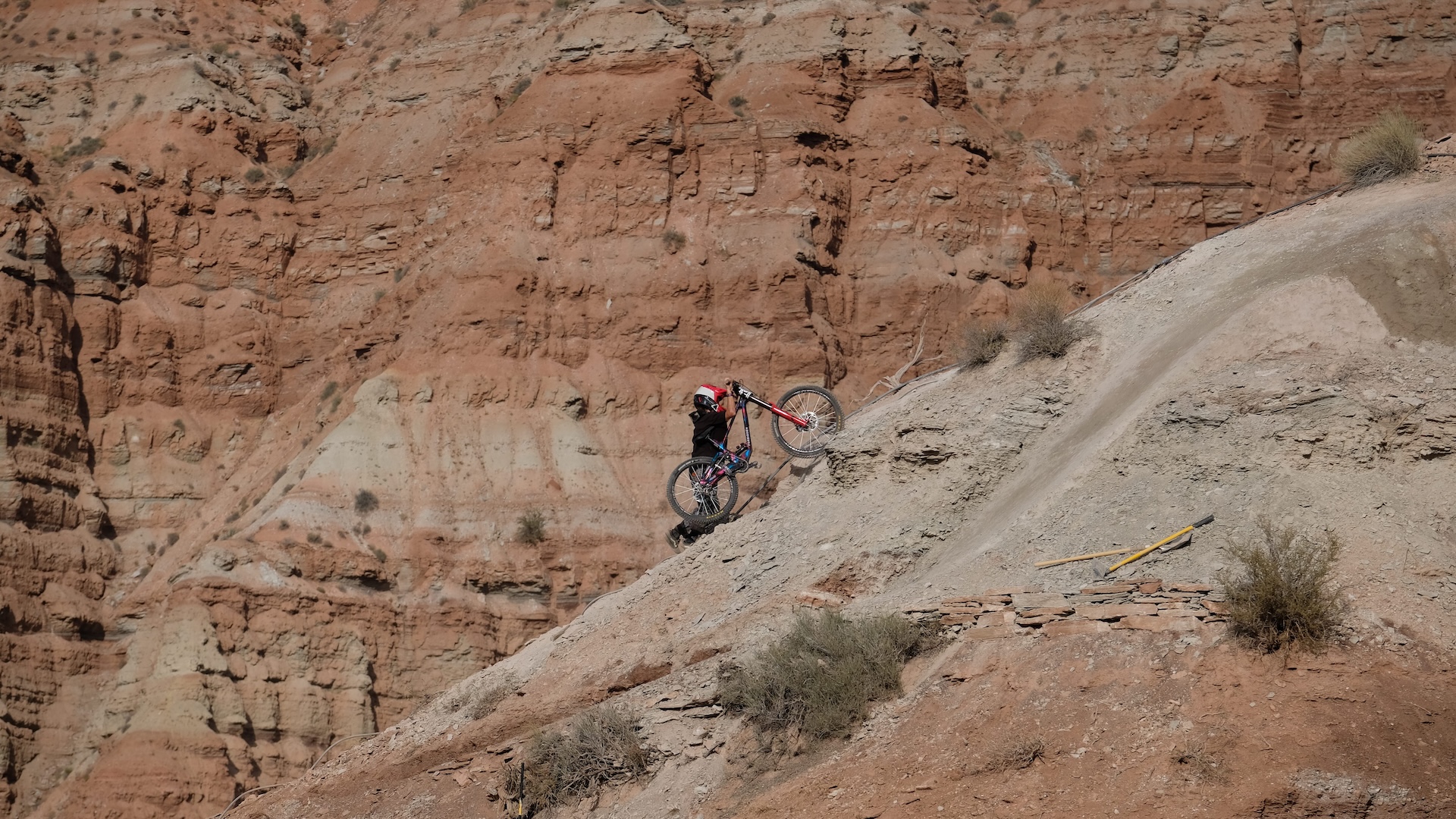
Energy conservation
Clemens Kaudela left Rampage in a helicopter – the outcome riders hope to avoid. Speaking during his recovery, he described how he’d ignored his gut feeling that he was too tired to ride. He’d seen others practising, and had pushed himself to get on the bike and ride, despite not feeling it and being exhausted from the dig days. It’s another illustration of just how important it is for riders to measure their efforts on the hill: it’s no good building a fabulous line if you’re too cooked to ride it. The diggers, too, have to stay on the right side of healthy. On the final dig day, Vinny Armstrong’s digger Jai Motherwell pushed on too long, and kept telling himself ‘just a bit longer’ would get the feature finished. He ended up needing an IV from the medics on site to treat his heatstroke.
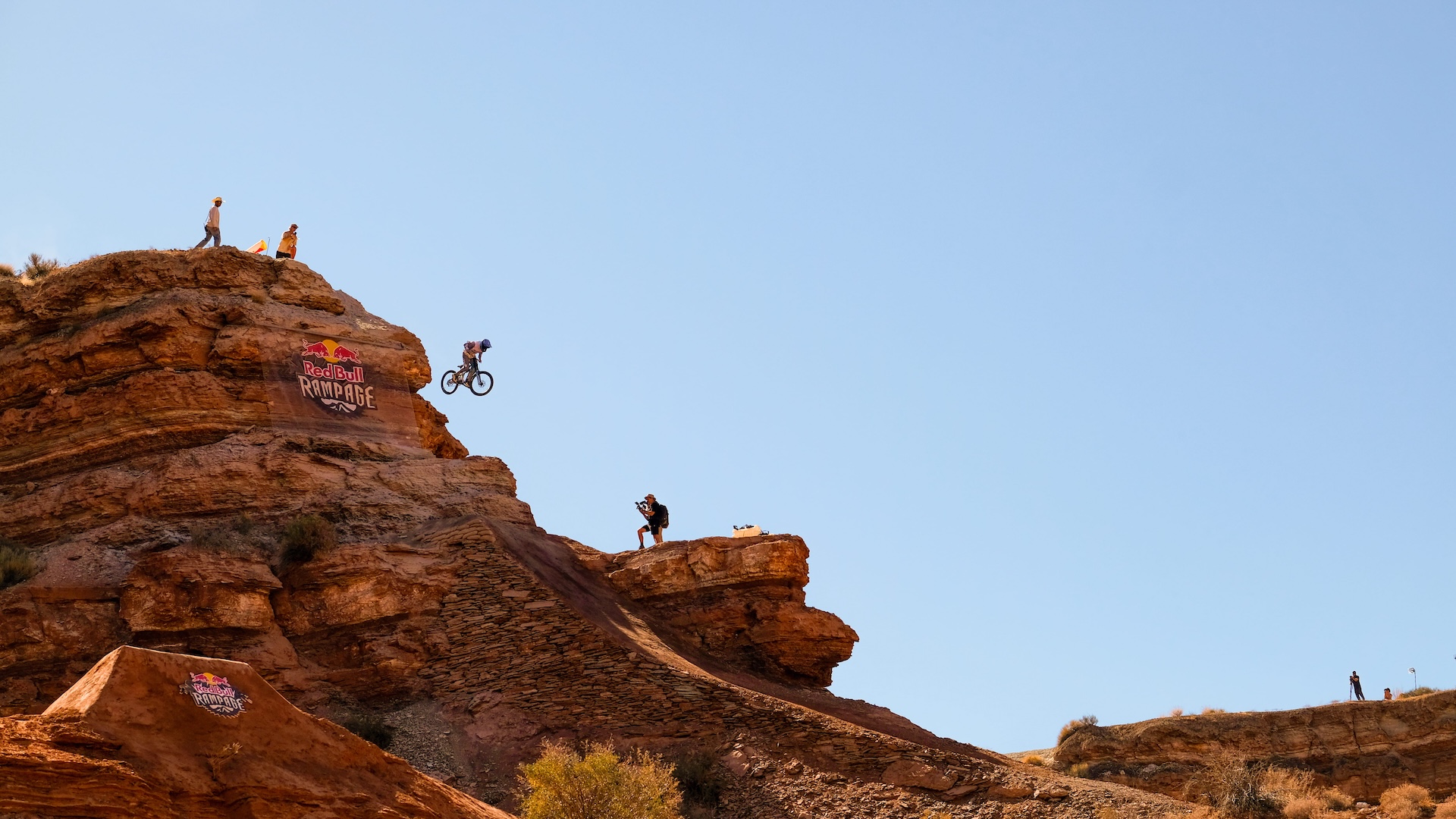
Include contingencies
Medical teams are another part of the set-up and infrastructure. Scattering the hillside, with numbers increasing as the work shifts from digging to practice, to competition, they keep an eye on everyone on site – including spectators. There’s a mix of medical staff from hospital, emergency medical and rescue service backgrounds, and while they hope to have a quiet time of it, just being out in the sun for days on end makes it a tough posting. By competition day, there will be 18 medics posted around the site, ready for a quick response if needed.
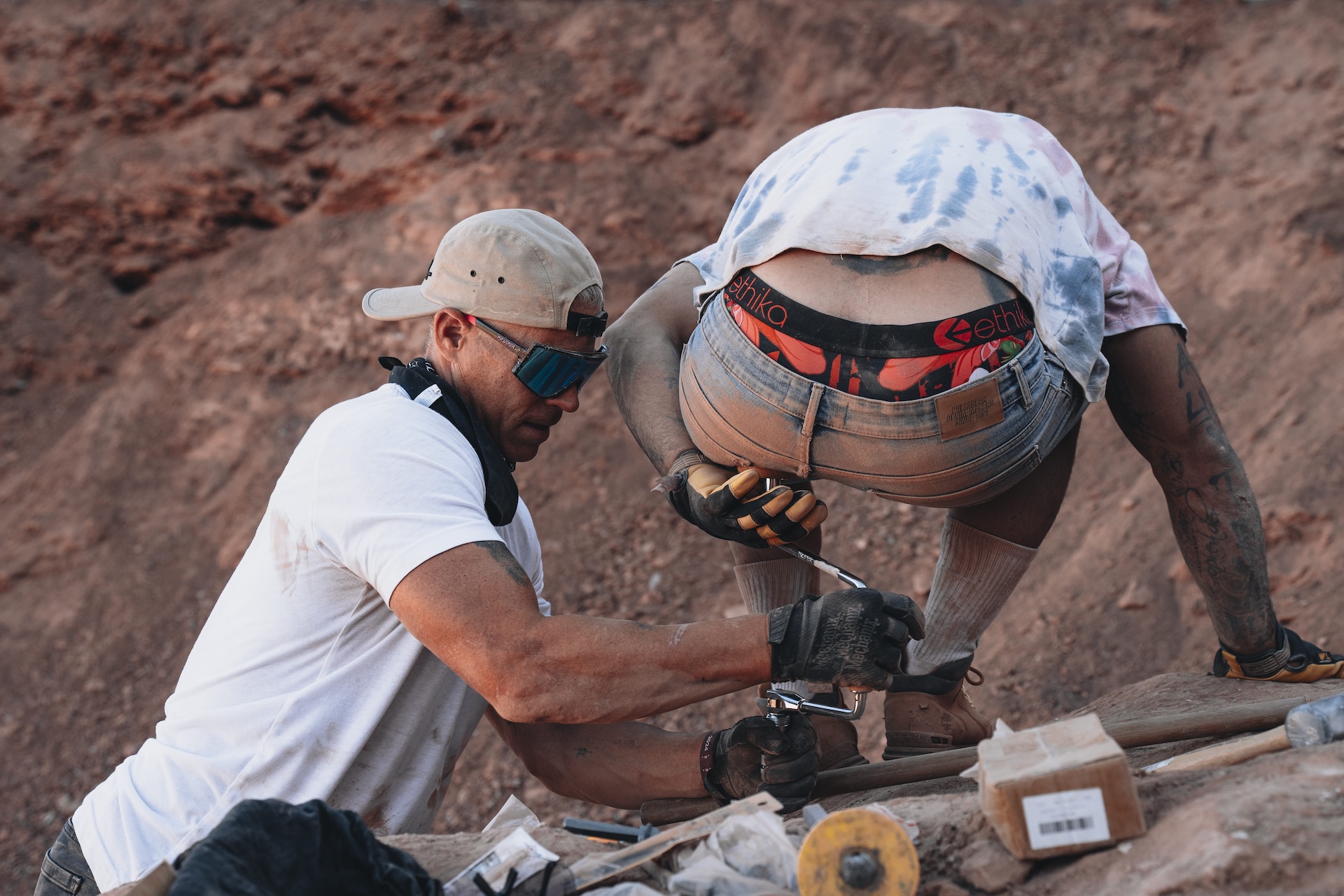
It’s testament to the riders’ skill and experience that the medics aren’t needed more often. While there are crashes that take riders out, there are plenty more tumbles from which they walk away. Often the rider knows a trick is going wrong while they’re still in the air, and they’ll bail, pushing the bike away from them and focusing on landing the fall or stopping before they fall off a cliff. Land on your arse and there’s nothing to absorb the impact of your fall; land feet first and you might absorb the shock through your knees – or you might blow out an ankle. Chelsea Kimball exhibited a masterclass in fall-arrest when she came off, twice, at the top of a cliff drop. Spreadeagled, she used both arms and legs to find purchase on the dusty layers of rock that form the cliff as her bike bounced off down below her. “Where’s my bike?”, she wondered, as she climbed back up.

While no one crunches the numbers on the hillside – it’s experience, judgement and intuition that are deployed, not cold maths – a rudimentary analysis of the forces in play illustrates the difference in consequence between success and failure. For Tom Isted and his canyon gap, the difference between crash-landing on his arse or staying on the bike and using the suspension is approximately 6000kg of force compared to 672kg. Staying on the bike means taking a hit that’s a little less than a professional boxer’s punch – crashing… oof. The numbers are inexact – you have to take in the difference in height of the take-off and landing, the speed and weight of the rider and bike, the arc they travel through the air… but have a play with the equations on paper and you can see that small alterations lead to big changes on those impact forces. It’s no wonder that the riders are so precise about the shape of their builds, shaving an inch off a take-off here, slapping in a landing there, or ripping it all out to move it back a couple of feet.

Hitting the on switch
At present, there’s no other mountain bike event that combines the digging and the competition. Digging offers riders the chance to be creative and imaginative, building a line that will allow them to perform at their best – whatever ‘best’ means to them. Big air, complex tricks, technical lines, heart-stopping exposure… it’s a package of potential, and the riders will try to lean in to where their skills are strongest. Just looking at the hillside and thinking ‘there’s a line there’ is a skill, and an exercise in vision and creativity. But whatever they put together is going to be judged, and winning means impressing the judges across the range of possibility: difficulty of line, air amplitude, control and fluidity, tricks, and style are all factors. The annual controversy over the judging is old news, practically a cliche. And while winning is good – there’s some serious prize money to be had – all the hype you see in the broadcast does little to convey the endurance and thought it takes to be so momentarily spectacular.
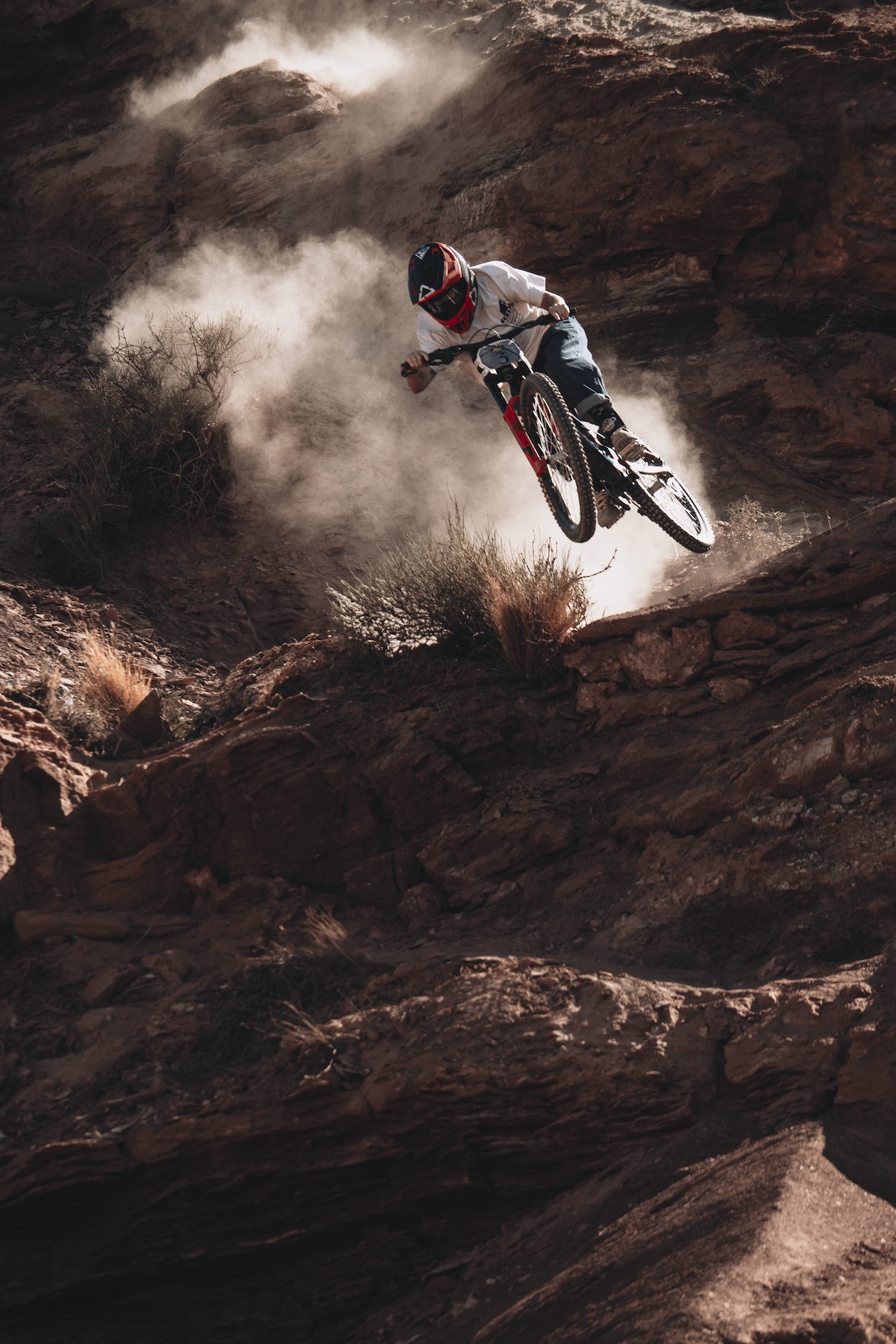
At Rampage, you are switched on. Rocks fall from above, your feet threaten to send more to those below. Don’t walk on someone’s line, don’t move around when someone is riding, don’t kick the rocks that are marking a take-off. Have you had enough to drink, how far down is it to get a refill? What will it cost you to climb up, versus what you will lose in retreating down to the shade of camp below? Exhausted teams do their best to stick to the essentials: eat, sleep, dig, ride. Some are organised enough to have a housekeeper back at their accommodation, preparing meals, doing the laundry, even giving massages. Like the marginal gains of roadies and track cyclists, the teams seek to conserve every ounce of energy possible. But sleep doesn’t come easy despite the exhausting physical demands – the mental strain of being ‘on it’ for so many long days and the anticipation of the final runs keep reels of images running through riders’ minds.
Lining up at the start gate, you picture your run. Braking points, speed markers, features and reset points. A few hundred metres of descent lie between you and the rush of stringing together the fear. You drop in, bursts of adrenaline and cortisol kick at your synapses as you tick off the features, somewhere between terrifying and delicious. The survival part of your brain forces the rush back, keeping you focused on the next feature, the next hit, the next trick, until you hit the last of the big stuff. Whooping and skidding into the finish corral, you let the chemistry flood your brain. All the judgement, calculation, effort and endurance comes together and you are repaid with the biggest adrenaline rush of your life. There are no numbers for this, and few words. But Robin Goomes, winner of the inaugural women’s Red Bull Rampage, captured the feeling breathlessly as she peels off her goggles after her winning run: “I’m so stoked to be alive.”
Thanks to Abus for covering Hannah’s travel expenses

Maths With Mark
We took Mark back to his physics teacher days and used video and photos of the BFC canyon gap to do a rough analysis of the kinds of forces the riders (and their bikes) are facing.
Caveats from Mark
A LOT of assumptions have been made and not inconsiderable guesses about the variables. That said, I think we get somewhere close to an idea of the forces involved in the end. Areas that I am cloudier about that could use some refining are things like the time it takes to compress a fork through its travel, which plays an important part in the final calculation of the forces dissipated and felt by the rider. I’m very much hoping someone with more time and accurate variables could refine all this to get more accurate answer.
Values I’ve attributed to variables:
Deformation time (impact to fork/shock) – 0.1 second
Tom – 70kg
Bike – guess at 13.5kg
162mm rear/ 180mm front shock
Tom’s BFC gap – 22.5m gap/ 1.6s airtime = 14.06m/s
Calculating the velocity at impact
Although the rider is on a parabolic path and travels some horizontal distance, this is almost a red herring as what we are really interested in is the vertical velocity at impact. That’s calculated by using the gravitational force from the top of the parabola to the impact point. ie. freefall velocity from maximum height of the rider to the landing point. In other words we need to calculate how high he gets and then how far down he falls. That will give us the impact velocity.
If his takeoff point was the same level as the landing then it would be simple: It’s his airtime/2 to give us the time taken to fall under gravity.
To calculate the impact force of an object falling from a height, we first need to determine its velocity just before impact and then estimate the force upon impact.
That can be found using this:
v=√2gh
Where g = gravitational force on Earth of 9.8 and h = height of drop of 3.2m.
This gives us a velocity of 7.9 m/s
Calculating the impact force
For our purposes we are taking this time as the time it takes the fork to compress through its travel. This is tricky and it’s where I start making some guesses. For simplicity I’ve picked 0.1s as the compression time. We can adjust the answer as needed by changing this value to something more accurate. Anyways.. for 0.1s here goes.
The equation we need is this one:
F=mΔv/Δt
Where m = 83.5, Δv=7.9 and Δt = time taken to compress the fork = 0.1
This gives us a value of 6596.5 Newtons
Which is 672kg of force at impact.
Calculating the impact force in a crash
To give us an idea of the way the suspension protects the rider let’s pretend the suspension is locked out. You might think this reduces compression time to practically 0s as there’s nothing to compress, but in reality something always gives. For the sake of argument let’s say Tom parts from the bike mid-flight and lands on his backside. His suspension is literally the skin and fat of his arse – a few millimetres, and he will probably crash through that compression in a VERY short period of time. Let’s say instead of the 0.1s we’ve used for the forks that we use 0.01s ie. 10x quicker. That gives us a huge impact force equivalent to over 6 tons.
Things not considered that make the maths extra complicated…
The rebound of the fork after impact, which exerts a force back into the rider. The value above would be as if the fork stayed at the bottom of its travel after impact. But it springs back, pushing (applying a force) back into the rider. The riders arms and legs take the brunt of that force of course and dissipate it. So here’s where it gets really messy. Over to you guys to play with these equations and come up with a better answer.





